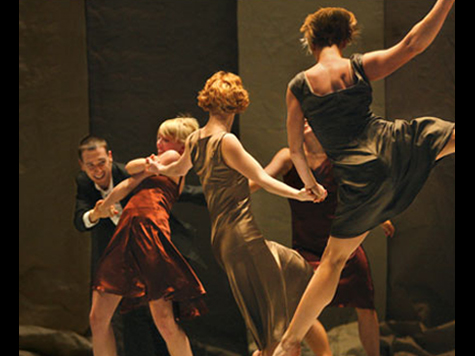Toronto Dance Theatre's Dis/(sol/ve)r explored gendered movement in ways that were thoughtful, impassioned, and unironic. A great deal of dance that I have seen lately has tended towards the cerebral, the conceptual, or the exceedingly technocratic, and so although a lack of irony can seem risky in this day and age, it was refreshing to watch a performance that dispensed with gimmicks and stated it's themes directly.
Dis/(sol/ve)r had a cast of nine, male and female. They occupied a stage hung with long swaths of linen in natural shades. The dancers, all young, wore dress clothes – suits for men and satin dresses for the women, in shades of tan, gold, copper, and metallic red. In pop-culture terms, they looked like a Vanity Fair young Hollywood cover-shoot – freshfaced, dapper twenty-somethings in conservative adult costume. Debutantes and their suitors at a modern ball.
The performance was most intriguing for how it dealt with the signification of these costumes, particularly in the men. For example, at a certain point in the performance one suited man lies on the stage and another stands straddled over him at the level of the chest. The standing man extends his hand to the one lying prone, but every time the man on the floor reaches for the proffered hand, the other man pulls it away.... It's a juvenile game of one-upmanship, but when the men are wearing suits, it seems to mean something. They are like dueling men with pistols at dawn – there's a sense that the games of adolescents become the games of men, for better or for worse.
Likewise, the movements of men and women together were inflected by the costumes and by the unselfconsciousness of their gestures. A woman covers a man's face with her hand. He reaches for her, tries to embrace her, but her suffocating hand keeps him at a distance. A man holds a woman by the head. They dance together, but with every step, the man turns the woman's head – she is completely at his mercy and moves when he moves.
The physical vocabulary of the dancers explored interdependence and power dynamics. During ensemble moments, the dancers would intertwine in long chains. There was something naturalistic and lovely in their camaraderie – they were a gang of youths falling in and out of love, learning to trust and test each other's loyalty. Duets explored interpersonal dynamics – especially love and fidelity. There was a distinct emphasis on gentlemanly interaction – the men dancing together, and in so doing, offering a subtle critique of norms of masculinity. It's not often in pop culture that we see a gang of men embracing outside of the scrum at the end of a winning game. Yet here were men in tights (so to speak) acting out all the scripted ideals of male bonding in the context of modern dance.
The dancers subtly tested the formulaic gender codes that so many of us unconsciously adhere to – one male dancer walked up to another and hugged him, unabashedly, for a long time. Eventually the embracee broke the grip. So the first man hugged him again. Dancers extended their movements to the point that very simple motions took on meaning – the hug between men that lasts, the grip of a woman on a man's arm that is too tight, the waltz that turns into a frenzied co-dependant march.
Periodically men and women, (and less frequently women and women or men and men) would pair off. One would try to embrace the other, only to find that the object of their affection had melted away – the embracee would fall to the floor rather than be embraced, captured, or constrained. The emotional impact was obviously a sense of loss for the ones embracing – how lonely, how sad that no one would return their yearning for connection, contact, recognition, or love.
Dis/(sol/ve)r offered viewers something sweet and simple, a nostalgic look at Western social norms. If it was limited, it was because it remained too long in this nostalgic moment. The piece was effective because of its pacing and persistent return to certain gestures. Movements that are part of everyday body language were extended and embellished, so that audiences could look self-consciously at the gender scripts being re-enacted on stage. Yet not much occurred that was outside of the script. Impassioned dancers embraced, split apart, returned to the arms of another, paused to regain composure and returned again to the dance. Dis/(sol/ve)r didn't shatter preconceptions. It wrote them large, dressed them in satin, and set them spinning on the stage. When the lights came down we had arrived nowhere that your average high school graduate has not been before.




